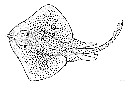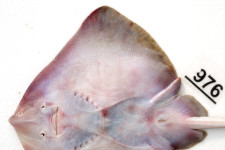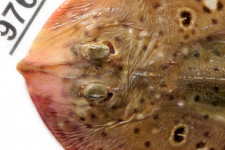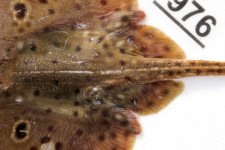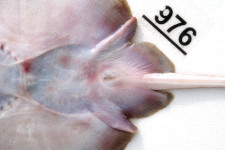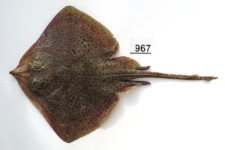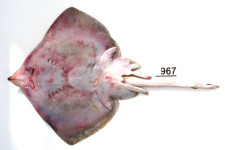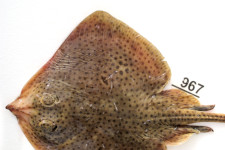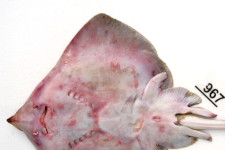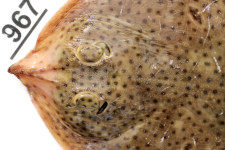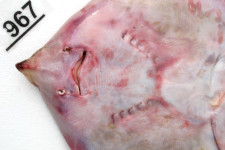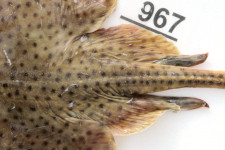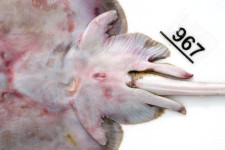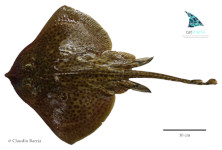Raja polystigma
Regan, 1923
Speckled ray
Classification: Elasmobranchii Rajiformes Rajidae
Reference of the original description
A new ray from the Mediterranean. Annals and Magazine of Natural History, (Series 9), 11(64), 529–530
A new ray from the Mediterranean. Annals and Magazine of Natural History, (Series 9), 11(64), 529–530
Image of the original description
No image in first description.
No image in first description.
Synonyms / new combinations and misspellings
Raia polystigma, Raja cf. polystigma, Raja (Raja) polystigma
Raia polystigma, Raja cf. polystigma, Raja (Raja) polystigma
Types
Raja polystigma
Syntype: BMNH: 1893.2.28.43, Nice BMNH: 1893.9.21.11, Zara BMNH: 1888.11.29.111 (ex MSNM) BMNH: 1893.9.21.12, Zara
Raja polystigma
Syntype: BMNH: 1893.2.28.43, Nice BMNH: 1893.9.21.11, Zara BMNH: 1888.11.29.111 (ex MSNM) BMNH: 1893.9.21.12, Zara
Description :
Citation: Raja polystigma Regan, 1923: In: Database of modern sharks, rays and chimaeras, www.shark-references.com, World Wide Web electronic publication, Version 12/2025
Please send your images of "Raja polystigma" to info@shark-references.com

Raja polystigma Regan, 1923, ERB 0976, female, 25, 8 cm DW, 39, 0 cm TL, Mediterranean, France © Frederik H. Mollen (Elasmobranch Research Belgium)

Raja polystigma Regan, 1923, ERB 0976, female, 25, 8 cm DW, 39, 0 cm TL, Mediterranean, France © Frederik H. Mollen (Elasmobranch Research Belgium)
Common names
 Gepunkteter Rochen,
Gepunkteter Rochen,  Manchada,
Manchada,  Raya manchada,
Raya manchada,  Raie tachetée,
Raie tachetée,  Speckled ray,
Speckled ray,  Speckled skate,
Speckled skate,  Razza polistima,
Razza polistima,  Razza polistimma
Razza polistimma
 Gepunkteter Rochen,
Gepunkteter Rochen,  Manchada,
Manchada,  Raya manchada,
Raya manchada,  Raie tachetée,
Raie tachetée,  Speckled ray,
Speckled ray,  Speckled skate,
Speckled skate,  Razza polistima,
Razza polistima,  Razza polistimma
Razza polistimma
Short Description
Characteristics after SERENA et al. [20312]: disc wider than long with margins sinuous. Snout very short with tip rounded and prickly. 50-60 tooth rows, acute in males, molar-like in females. Dorsal side smooth with some thornlets on anterior margins. Some pre and post-orbital thorns, one nuchal, 1-2 rows of alars, one group of malar thorns. Tail prickly with a median row of 22-28 thorns and sometimes parallel rows of thorns, none between dorsal fins. Ventral side smooth, except for snout spinulose. Colour brown with an irregular pattern of dark dots and light blotches, narrow white band surrounding the disc, often blotches similar to eyespots on wings.
Characteristics after SERENA et al. [20312]: disc wider than long with margins sinuous. Snout very short with tip rounded and prickly. 50-60 tooth rows, acute in males, molar-like in females. Dorsal side smooth with some thornlets on anterior margins. Some pre and post-orbital thorns, one nuchal, 1-2 rows of alars, one group of malar thorns. Tail prickly with a median row of 22-28 thorns and sometimes parallel rows of thorns, none between dorsal fins. Ventral side smooth, except for snout spinulose. Colour brown with an irregular pattern of dark dots and light blotches, narrow white band surrounding the disc, often blotches similar to eyespots on wings.
Distribution
Northeast Atlantic: known only from the western Mediterranean, more common along the African coasts. Source: www.gbif.org
Northeast Atlantic: known only from the western Mediterranean, more common along the African coasts. Source: www.gbif.org
Biology
Oviparous, paired eggs are laid. Embryos feed solely on yolk [733]. Ripe females occurring mostly in the winter and deposit 20 to 62 egg-cases per year depending on size [7182]. Distinct pairing with embrace. Y oung may tend to follow large objects, such as their mother [17086]. Found mainly on soft bottoms. Feeds mainly on crustaceans and bony fishes depending on the sex, size and also partly with the season.
Oviparous, paired eggs are laid. Embryos feed solely on yolk [733]. Ripe females occurring mostly in the winter and deposit 20 to 62 egg-cases per year depending on size [7182]. Distinct pairing with embrace. Y oung may tend to follow large objects, such as their mother [17086]. Found mainly on soft bottoms. Feeds mainly on crustaceans and bony fishes depending on the sex, size and also partly with the season.
Remarks
shark-references Species-ID=5745;
shark-references Species-ID=5745;








